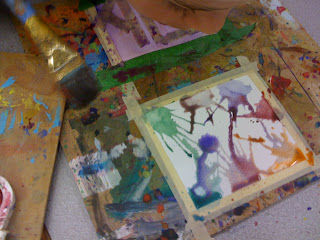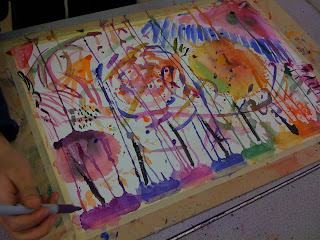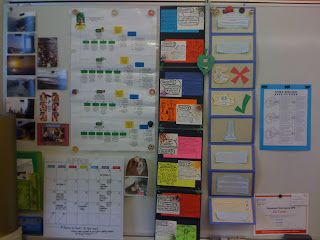Watercolor. What a wonderful media for Middle School Students. It can be so technical when you are aiming to do a detailed painting, yet it can be so freeing when you let students go wild with few restrictions and requirements!
I have done two assignments with watercolor so far, and both have turned out to be some of my favorite assignments of all of them. Here they are.
Grade 6 Mini Watercolor Paintings.
I was shown this assignment during one of my practicums in a local junior high school, and fell in love with it. (Thank you Mrs. Cook!) The first two times I did this assignment in my classroom, it was an instant success. I began the assignment with a brief intro about watercolor and the various techniques that I wanted them to play around with. I then showed them a massive pile of miniature watercolor paper pieces, and told them that they could go wild, and create as many as time allows over 2-3 classes. At the end, they would hand in their favorite 10 for marks. The assignment was a huge resounding success, and it was so amazing to watch it unfold.
Here is how I introduced this assignment the third, and most recent time. "Here are some mini canvases, here is a watercolor palette, a paintbrush and a bucket of water. Go."
The most amazing thing happened. Students created the same kinds of mini paintings, with a variety of colors, patterns, textures, techniques, images, etc. But this time, the experience was even more amazing to watch. Because I did not begin with a demo, the students discovered the techniques themselves! Each discovery was monumentally exciting for the individual, and rippled throughout the class. That discovery, led to another, which led to a related idea. It really was beautiful to watch these students explore the media with no restrictions, uncover techniques and skills all by themselves, produce amazing little artworks, and come back the next class begging to do more.
This assignment is a keeper.
 |
| Playing... |
 |
| Experimenting... |
 |
| Trying... |
 |
| Some finished pieces! So different from one another! |
 |
| More finished pieces... |
 |
| ...and some more finished pieces. Sorry that this picture is upside down, I can not figure out how to rotate it... but it had to be shown! The ninja panda paintings are so great! |
|
Grade 7 Watercolor Doodle.
This assignment came about because my first group of Grade 7 Art students was coming to an end and I only had three classes left with them. I knew I needed to do something short, and I knew I wanted it to be a painting project as we had not done any painting projects yet. So I came up with this based on something I had done when I was living in Spain. I used to carry around a small watercolor palette, and I would do these small watercolor abstract paintings. I would then later go back into the painting with a pen and doodle on top. I always loved how they turned out, and it was fun making them because it was abstract, and I never knew how it was going to turn out.
So, at the beginning of the first class, I gave them a large sheet of watercolor paper and gave them a few guidelines. I wanted them to work abstractly, filling up the page with colors, designs and layers of watercolor. The more layered and complex, the more interesting their final product will be. We talked about abstract art a bit, and we also talked about spontaneity combined with thoughtful composition.
 |
| Phase one. Play with watercolor. |
At the beginning of the second class, I laid out ton of different colors of sharpies, and I told them that they were now going to doodle on top of the watercolor using sharpies. I asked them to keep in mind the idea of an abstract painting, spontaneity, and thoughtful composition. But this round, the sharpie additions needed to be inspired by their watercolor composition.
 |
| A result of phase one, playing with watercolor. |
 |
| Phase two. Doodle with sharpies. |
 |
| More doodling. |
 |
| More doodling. |
 |
| This one was mine. It started off as a demo piece, but the more I saw the kids pieces, the more I wanted to do on mine! It was so much fun! |
The students absolutely loved this assignment. On the course evaluation, it was almost unanimous that this was their favorite project. The loved the freedom that it gave them, and idea of taking experimentation one step further by combining it with composition and mixed media. Once again, a huge success.
This assignment is also a keeper!
The other art teacher who I share the art room with also does a watercolor painting in Grade 8, wear the students paint a scenic background, then add a black silhouette of a something in the foreground. So it seems like a nice progression from Grade 6-8, beginning with complete experimentation, then abstraction, then moving to more detailed realism.
Questions for Future Improvement:
- Does giving guidance and demonstration before hand help or hinder the creative process? I would think that it would depend on what I wanted out of the project. For example, the Mini-Watercolor Paintings, I want to students to have complete freedom resulting in discoveries, so the demo hinders that process a little. The Watercolor Doodle assignment on the other hand requires some guidance in terms of the abstraction with thoughtful composition, and having the doodling work with the watercolor, not against it. Or does it?
- With the Watercolor Doodle assignment, I gave them the instructions in steps, so they did not know that we would be going back into their paintings with sharpies. I quickly discovered that if I was going to keep this a secret, I needed to constantly remind them during the painting phase to keep the colors light, and layered, so that the sharpie would show up. The result was mostly positive, but there were a few students who discovered that they had gone too dark too quickly, and many of the sharpies did not work. Should I have kept the second part a secret? What does it achieve in doing that?
























































